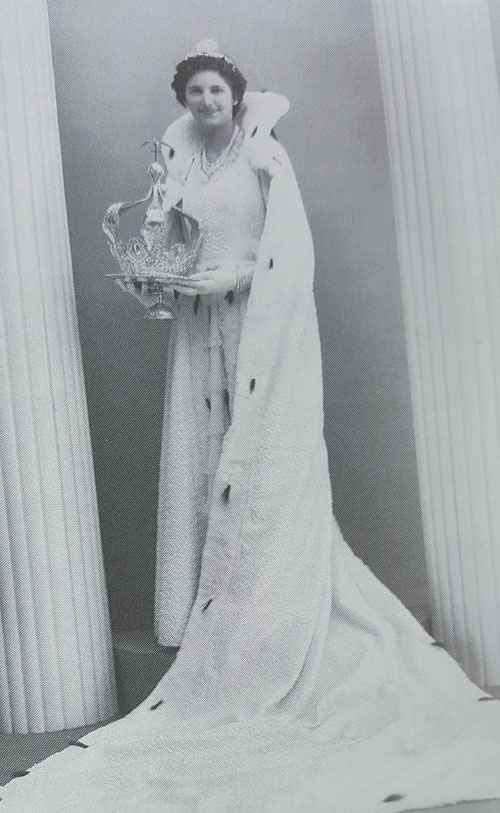
The Festa do Divino Espírito Santo – festival of the Holy Spirit – is the most important event of the year for Santa Clara’s Portuguese fraternal organization, the Sociedade do Espírito Santo (S.E.S.). But this year’s festa, on May 21 and 22, is even more important. It’s the 120th birthday of the S.E.S., which was founded in 1896 in Santa Clara. The first Holy Spirit festa was held two years before that, according to a 1912 Santa Clara Journal article.
The event is held on Trinity Sunday, the Sunday after the Christian holiday of Pentecost (50 days after Easter) celebrating the Holy Spirit.
The height of the two-day celebration is the round-trip parade Sunday morning to St. Clare’s Church. The magnificent Festa Rainhas (Festival Queens), in their traditional and hand-made embroidered capes, and their maids in matching stoles, take center stage.
Accompanying them is Santa Clara’s own Sociedade Filarmonica Uniao Portuguesa (United Portuguese Philharmonic Society) marching band, Portuguese bands and festa queens from all over California, and rose-covered floats carrying statues of the S.E.S. patron saints.
When the parade returns from St. Clare’s to the S.E.S. Hall, there is a community feast of sopas – a traditional dish of savory stewed meat, broth and cabbage served over bread – that is free to all who come.
Following lunch, people can enjoy an auction, Portuguese sweets – suspiros (meringues), bolachas de acucor cookies, and pungent St. Jorge cheese – and enjoy music from the Portuguese band. Hefty loaves of Portuguese sweet bread are also for sale. The festa closes in the evening with the distribution of traditional Rosquilhas, cookies that symbolize the sweetness of the Holy Spirit.
Old-World Tradition in Santa Clara
The S.E.S. is closely connected with the history of Santa Clara – reflecting the City’s significant Portuguese community both then and now.
The fraternal organization was incorporated on Jan. 2, 1896 with five officers – Manuel Vargas, Jose Soares, Manuel Faria, Mariano Denis and Jose Mariante. The document was notarized by Antonio Fatjo – who started some of Santa Clara’s first businesses and was described in his 1917 obituary as a “first citizen” of Santa Clara.
A century ago the festa was a huge event for Santa Clara.
In 1916, the upcoming festivals – there were two – were described as “the biggest in the history of the society” by the May 31, 1916 Mercury Herald.
“The streets were thronged with visitors,” the Herald wrote on June 17, 1916. “Electric cars crowded, and large numbers of visitors were at both fiesta headquarters, where the surroundings for some time were illuminated with a large and pretty display of fireworks…Colored skyrockets in difference sections of the town occasioned interest in the affair.”
The following year the Herald reported that 15,000 people attended 1917’s event, where Saturday night’s dancing lasted until 5 o’clock Sunday morning.
The fireworks continued at least into the 1950s, when the May 28, 1953 Santa Clara Journal wrote, “Santa Clarans are forewarned that on Saturday night and Sunday aerial bombs will be set off as part of the celebration.”
Almost 1,000 Year-Old Folk Religious Tradition
Veneration of the Holy Spirit, traditionally pictured as a dove, is a deeply-rooted religious folk tradition in the Azores, the ancestral home of many Portuguese in the Santa Clara Valley.
Devotion to the Holy Spirit dates back to a 12th century mystic, Joachim of Fiore, who believed that the second millennium would usher in the Age of the Holy Spirit, an age of brotherhood and enlightenment analogous to the 1960s belief in the Age of Aquarius.
In the 16th century, the Inquisition obliterated the tradition in mainland Portugal – Joachim taught that the new age would make the Church unnecessary – and the traditional practices only survived in the Azores, which was separated from the Inquisition by 900 miles of water. (Today, the tradition is encouraged by the Catholic Church as a ‘pious practice.’)
The tradition of the Rainhas comes from the Portuguese queen St. Isabel of Aragon (1271- 1336), known for her generosity to the poor. After the death of her husband, King Denis of Portugal, she joined the Coimbra convent of the Poor Clare nuns, founded in 1314 by St. Clare, for whom the City of Santa Clara is named.
Isabel devoted the rest of her life to the service of others and was known throughout her life as a peacemaker between the perennially warring nobility. One tradition says that she introduced the special veneration of the Holy Spirit to Portugal. She is buried in Monastery of Santa Clara-a-Nova in Coimbra – Santa Clara’s Sister City – and was canonized in 1625.
Join the Celebration
This year the Sunday festival parade begins at 9:30 a.m. on May 22 at the S.E.S. Hall on 1375 Lafayette at Lewis, and proceeds to St. Claire’s Church on 941 Lexington, for a 10:30 Mass. The return trip starts at about 11:30. Lunch follows at the S.E.S. Hall, and everyone is welcome. For more information about the S.E.S., visit myseshall.org or call 408-243-0811.
The next S.E.S. parade and festa is St. Anthony of Padua on Sunday July 10. Anthony was a 13th century Portuguese priest and teacher.
Mary Boyle of the Santa Clara City Library, S.E.S. treasurer Mike Castro, and the S.E.S.’s centennial history “100 Years of Devotion to the Holy Spirit and of Community Service” provided information for this story.





